Belts Hyundai Accent 2011 User Guide
[x] Cancel search | Manufacturer: HYUNDAI, Model Year: 2011, Model line: Accent, Model: Hyundai Accent 2011Pages: 282, PDF Size: 14.82 MB
Page 38 of 282
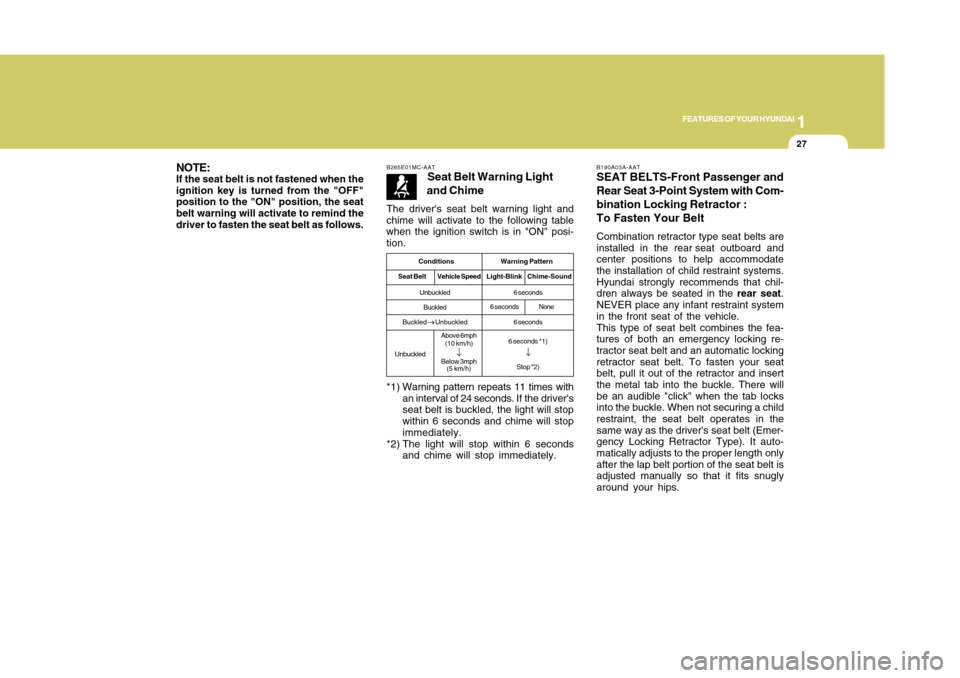
1
FEATURES OF YOUR HYUNDAI
271
FEATURES OF YOUR HYUNDAI
27
NOTE:If the seat belt is not fastened when the
ignition key is turned from the "OFF"
position to the "ON" position, the seat
belt warning will activate to remind the
driver to fasten the seat belt as follows.The driver's seat belt warning light and
chime will activate to the following table
when the ignition switch is in "ON" posi-
tion.
B265E01MC-AAT
Seat Belt Warning Light
and ChimeConditions Warning Pattern
Seat BeltVehicle SpeedLight-Blink Chime-SoundUnbuckled
Buckled
Buckled
→ →→ →
→ Unbuckled
UnbuckledAbove 6mph
(10 km/h)
↓
Below 3mph
(5 km/h)6 seconds
6 seconds
6 seconds *1)
↓Stop *2)
6 secondsNone
B190A03A-AATSEAT BELTS-Front Passenger and
Rear Seat 3-Point System with Com-
bination Locking Retractor :
To Fasten Your BeltCombination retractor type seat belts are
installed in the rear seat outboard and
center positions to help accommodate
the installation of child restraint systems.
Hyundai strongly recommends that chil-
dren always be seated in the rear seat.
NEVER place any infant restraint system
in the front seat of the vehicle.
This type of seat belt combines the fea-
tures of both an emergency locking re-
tractor seat belt and an automatic locking
retractor seat belt. To fasten your seat
belt, pull it out of the retractor and insert
the metal tab into the buckle. There will
be an audible "click" when the tab locks
into the buckle. When not securing a child
restraint, the seat belt operates in the
same way as the driver's seat belt (Emer-
gency Locking Retractor Type). It auto-
matically adjusts to the proper length only
after the lap belt portion of the seat belt is
adjusted manually so that it fits snugly
around your hips. *1) Warning pattern repeats 11 times with
an interval of 24 seconds. If the driver's
seat belt is buckled, the light will stop
within 6 seconds and chime will stop
immediately.
*2) The light will stop within 6 seconds
and chime will stop immediately.
Page 39 of 282

1FEATURES OF YOUR HYUNDAI28
!
WARNING:
!
B200A01A-AATAdjusting Your Seat Belt
WARNING:You should place the lap belt portion as
low as possible and snugly across your
hips, not on your waist. If the lap belt is
located too high on your waist, it may
increase the chance of injury in the event
of a collision. Both arms should not be
under or over the belt. Rather, one should
be over and the other under, as shown in
the illustration.
Never wear the seat belt under the arm
nearest the door.
B200A01NF
o Children age 12 and younger must
always be properly restrained in the
rear seat. Never allow children to
ride in the front passenger seat. If a
child over 13 must be seated in the
front seat, he/she must be properly
belted and the seat should be moved
as far back as possible.
o Never wear the shoulder belt under
your arm or behind your back. An
improperly positioned shoulder belt
can cause serious injuries in a crash.
The shoulder belt should be posi-
tioned midway over your shoulder
across your collarbone.
o Avoid wearing twisted seat belts. A
twisted belt can't do its job as well. In
a collision, it could even cut into you.
Be sure the belt webbing is straight
and not twisted.
o Be careful not to damage the belt
webbing or hardware. If the belt web-
bing or hardware is damaged, re-
place it. When the seat belt is fully extended from
the retractor to allow the installation of a
child restraint system, the seat belt opera-
tion changes to allow the belt to retract,
but not to extend (Automatic Locking
Retractor Type). See page 1-38.
NOTE:Although the combination retractor pro-
vides the same level of protection for
seated passengers in either emergency
or automatic locking modes, it is recom-
mended that seated passengers use the
emergency locking feature for improved
convenience. The automatic locking
function is intended to facilitate child
restraint installation. To convert from
the automatic locking feature to the
emergency locking operation mode, al-
low the unbuckled seat belt to fully re-
tract.
!
WARNING:
o For maximum restraint system pro-
tection, seat belts must always be
used whenever the car is moving.
o Seat belts are most effective when
seatbacks are in the upright posi-
tion.
Page 40 of 282
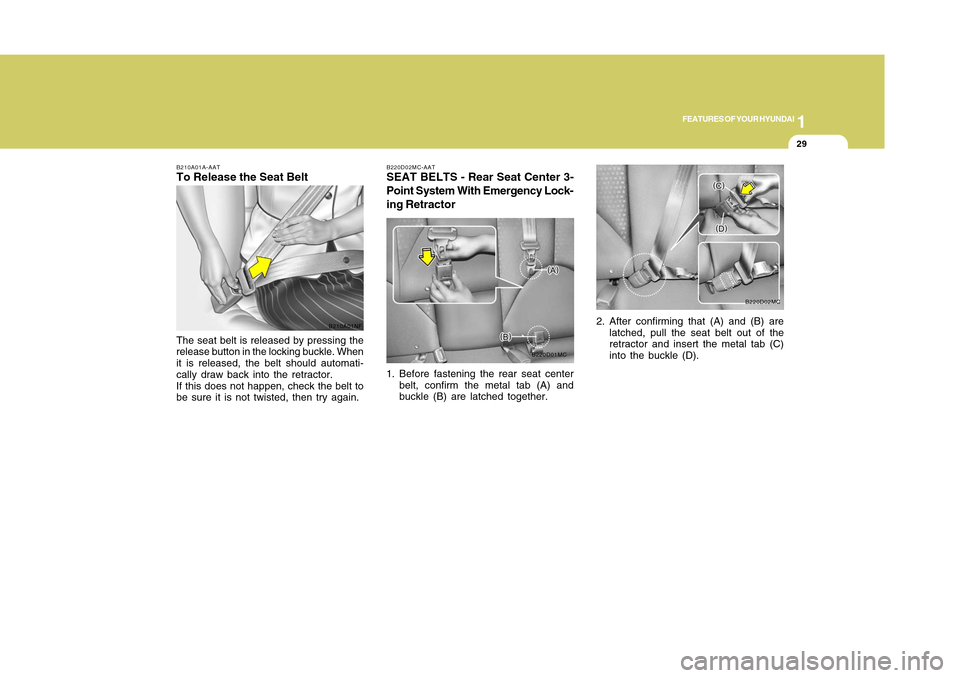
1
FEATURES OF YOUR HYUNDAI
291
FEATURES OF YOUR HYUNDAI
29
B210A01A-AATTo Release the Seat BeltThe seat belt is released by pressing the
release button in the locking buckle. When
it is released, the belt should automati-
cally draw back into the retractor.
If this does not happen, check the belt to
be sure it is not twisted, then try again.
B210A01NF
B220D02MC-AATSEAT BELTS - Rear Seat Center 3-
Point System With Emergency Lock-
ing Retractor1. Before fastening the rear seat center
belt, confirm the metal tab (A) and
buckle (B) are latched together.
B220D01MC
2. After confirming that (A) and (B) are
latched, pull the seat belt out of the
retractor and insert the metal tab (C)
into the buckle (D).
B220D02MC
Page 42 of 282

1
FEATURES OF YOUR HYUNDAI
311
FEATURES OF YOUR HYUNDAI
31
!
B220D05MC
To disconnect the metal tab (A) from the
buckle (B), insert a narrow-ended tool
into the groove located on the buckle (B).
WARNING:
Always lock metal tab (A) into buckle (B)
immediately after returning the rear
seatbacks to an upright position. This
portion of the rear center seat belt should
only be unbuckled when the rear
seatback is folded down.
!
B220C02A-GATTo Release the Seat BeltWhen you want to release the seat belt,
press the button in the locking buckle.
WARNING:
When fastening the outboard seat belts
or the center seat belt, make sure they
are inserted into the correct buckles to
obtain maximum protection from the seat
belt system and assure proper opera-
tion.
B210A01NF
CHILD RESTRAINT SYSTEMB230A05A-AATChildren riding in the car should sit in the
rear seat and must always be properly
restrained to minimize the risk of injury in
an accident, sudden stop or sudden
maneuver. According to accident statis-
tics provided by the National Highway
Traffic Safety Administration (NHTSA),
children are safer when properly re-
strained in the rear seats than in the front
seat. Larger children not in a child re-
straint should use one of the seat belts
provided.
All 50 states have child restraint laws.
You should be aware of the specific re-
quirements in your state. Child and/or
infant safety seats must be properly placed
and installed in the rear seat. You must
use a commercially available child re-
straint system that meets the requirements
of the Federal Motor Vehicle Safety Stan-
dards (FMVSS).
Child restraint systems are designed to
be secured in vehicle seats by lap belts
or the lap belt portion of a lap/shoulder
belt, or by a LATCH system.
Children could be injured or killed in a
crash if their restraints are not properly
secured.
Page 43 of 282

1FEATURES OF YOUR HYUNDAI32
!
o Never hold a child in your arms or lap
when riding in a vehicle. The violent
forces created during a crash will
tear the child from your arms and
throw the child against the car’s inte-
rior.
o Never put a seat belt over yourself
and a child. During a crash, the belt
could press deep into the child caus-
ing serious internal injuries.
o Never leave children unattended in a
vehicle – not even for a short time.
The car can heat up very quickly,
resulting in serious injuries to chil-
dren inside. Even very young chil-
dren may inadvertently cause the
vehicle to move, entangle them-
selves in the windows, or lock them-
selves or others inside the vehicle.
o Never allow two children, or any two
persons, to use the same seat belt.
o Children often squirm and reposition
themselves improperly. Never let a
child ride with the shoulder belt un-
der their arm or behind their back.
Always properly position and secure
children in rear seat.
WARNING:
o When the child restraint system is
not in use, store it in the trunk or
fasten it with a safety belt so that it
will not be thrown forward in case of
a sudden stop or an accident.
o Children may be seriously injured or
killed by an inflating airbag. All chil-
dren, even those too large for child
restraints, must ride in the rear seat.
To reduce the chance or serious or fatal
injuries:
o Children of all ages are safer when
restrained in the rear seat. A child
riding in the front passenger seat
can be forcefully struck by an inflat-
ing airbag resulting in serious or fa-
tal injuries.
o Always follow the instructions for
installation and use of the child re-
straint maker.
o Always make sure the child seat is
secured properly in the car and your
child is securely restrained in the
child seat.
!
WARNING:
WARNING:
o A child restraint system must be
placed in the rear seat. Never install
a child or infant seat on the front
passenger's seat.
Should an accident occur and cause
the passenger side airbag to deploy,
it could severely injure or kill an
infant or child seated in an infant or
child seat. Thus, only use a child
restraint in the rear seat of your
vehicle.
o Since a safety belt or child restraint
system can become very hot if it is
left in a closed vehicle, be sure to
check the seat cover and buckles
before placing a child there.
!
For small children and babies, a child
seat or infant seat must be used. Before
buying a particular child restraint system,
make sure it fits your car seat and seat
belts, and fits your child. Follow all the
instructions provided by the manufacturer
when installing the child restraint system.
Page 44 of 282
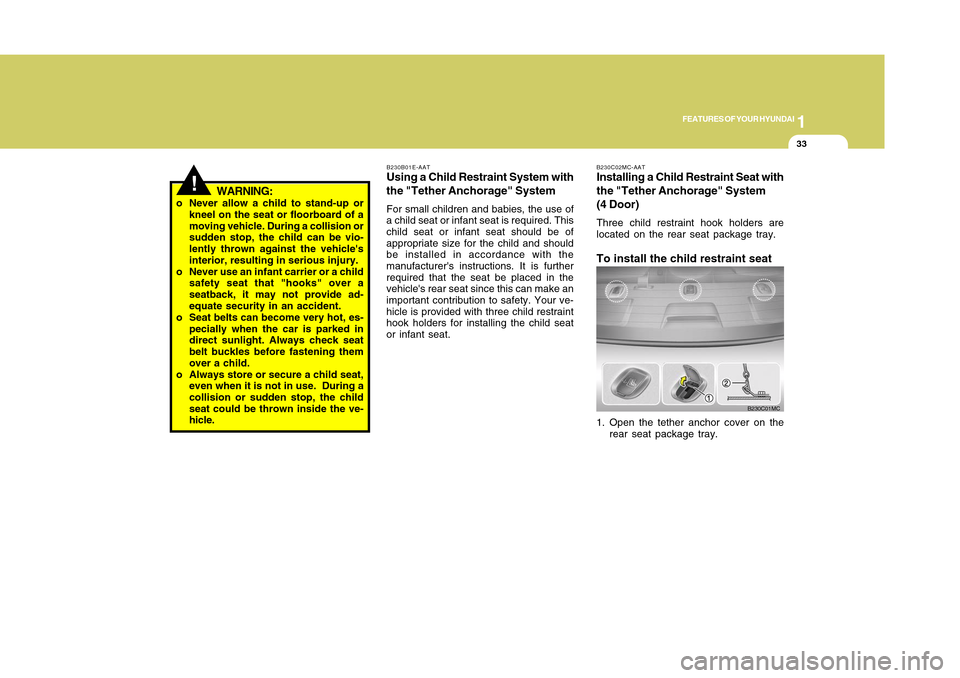
1
FEATURES OF YOUR HYUNDAI
331
FEATURES OF YOUR HYUNDAI
33
!
WARNING:
o Never allow a child to stand-up or
kneel on the seat or floorboard of a
moving vehicle. During a collision or
sudden stop, the child can be vio-
lently thrown against the vehicle's
interior, resulting in serious injury.
o Never use an infant carrier or a child
safety seat that "hooks" over a
seatback, it may not provide ad-
equate security in an accident.
o Seat belts can become very hot, es-
pecially when the car is parked in
direct sunlight. Always check seat
belt buckles before fastening them
over a child.
o Always store or secure a child seat,
even when it is not in use. During a
collision or sudden stop, the child
seat could be thrown inside the ve-
hicle.
B230B01E-AATUsing a Child Restraint System with
the "Tether Anchorage" SystemFor small children and babies, the use of
a child seat or infant seat is required. This
child seat or infant seat should be of
appropriate size for the child and should
be installed in accordance with the
manufacturer's instructions. It is further
required that the seat be placed in the
vehicle's rear seat since this can make an
important contribution to safety. Your ve-
hicle is provided with three child restraint
hook holders for installing the child seat
or infant seat.
B230C02MC-AATInstalling a Child Restraint Seat with
the "Tether Anchorage" System
(4 Door)Three child restraint hook holders are
located on the rear seat package tray.To install the child restraint seat
B230C01MC
1. Open the tether anchor cover on the
rear seat package tray.
Page 46 of 282
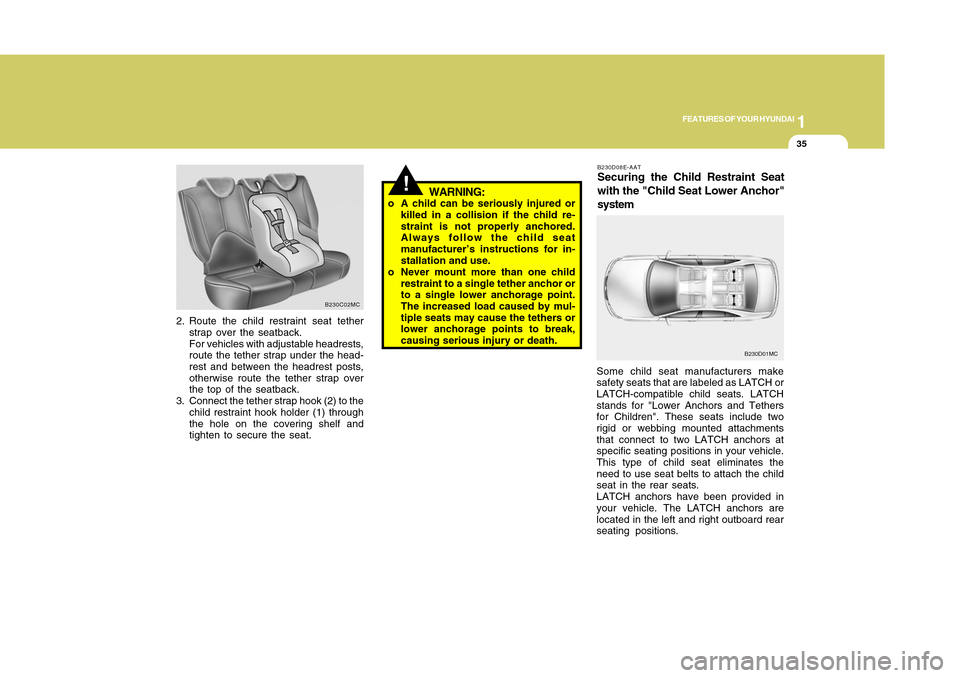
1
FEATURES OF YOUR HYUNDAI
351
FEATURES OF YOUR HYUNDAI
35
B230C02MC
2. Route the child restraint seat tether
strap over the seatback.
For vehicles with adjustable headrests,
route the tether strap under the head-
rest and between the headrest posts,
otherwise route the tether strap over
the top of the seatback.
3. Connect the tether strap hook (2) to the
child restraint hook holder (1) through
the hole on the covering shelf and
tighten to secure the seat.
!
WARNING:
o A child can be seriously injured or
killed in a collision if the child re-
straint is not properly anchored.
Always follow the child seat
manufacturer’s instructions for in-
stallation and use.
o Never mount more than one child
restraint to a single tether anchor or
to a single lower anchorage point.
The increased load caused by mul-
tiple seats may cause the tethers or
lower anchorage points to break,
causing serious injury or death.
B230D08E-AATSecuring the Child Restraint Seat
with the "Child Seat Lower Anchor"
systemSome child seat manufacturers make
safety seats that are labeled as LATCH or
LATCH-compatible child seats. LATCH
stands for "Lower Anchors and Tethers
for Children". These seats include two
rigid or webbing mounted attachments
that connect to two LATCH anchors at
specific seating positions in your vehicle.
This type of child seat eliminates the
need to use seat belts to attach the child
seat in the rear seats.
LATCH anchors have been provided in
your vehicle. The LATCH anchors are
located in the left and right outboard rear
seating positions.
B230D01MC
Page 47 of 282
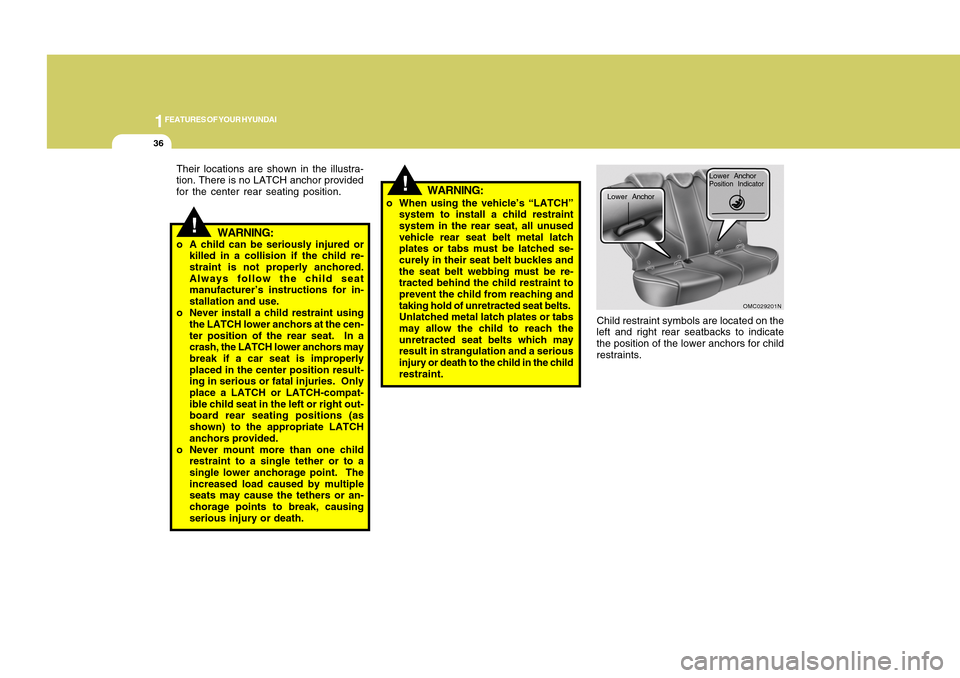
1FEATURES OF YOUR HYUNDAI36
Child restraint symbols are located on the
left and right rear seatbacks to indicate
the position of the lower anchors for child
restraints.
OMC029201N
Lower Anchor
Lower AnchorPosition Indicator
!
o When using the vehicle’s “LATCH”
system to install a child restraint
system in the rear seat, all unused
vehicle rear seat belt metal latch
plates or tabs must be latched se-
curely in their seat belt buckles and
the seat belt webbing must be re-
tracted behind the child restraint to
prevent the child from reaching and
taking hold of unretracted seat belts.
Unlatched metal latch plates or tabs
may allow the child to reach the
unretracted seat belts which may
result in strangulation and a serious
injury or death to the child in the child
restraint.
WARNING:
WARNING:
o A child can be seriously injured or
killed in a collision if the child re-
straint is not properly anchored.
Always follow the child seat
manufacturer’s instructions for in-
stallation and use.
o Never install a child restraint using
the LATCH lower anchors at the cen-
ter position of the rear seat. In a
crash, the LATCH lower anchors may
break if a car seat is improperly
placed in the center position result-
ing in serious or fatal injuries. Only
place a LATCH or LATCH-compat-
ible child seat in the left or right out-
board rear seating positions (as
shown) to the appropriate LATCH
anchors provided.
o Never mount more than one child
restraint to a single tether or to a
single lower anchorage point. The
increased load caused by multiple
seats may cause the tethers or an-
chorage points to break, causing
serious injury or death.
!
Their locations are shown in the illustra-
tion. There is no LATCH anchor provided
for the center rear seating position.
Page 50 of 282

1
FEATURES OF YOUR HYUNDAI
391
FEATURES OF YOUR HYUNDAI
39
The seat belt pre-tensioner system con-
sists mainly of the following components.
Their locations are shown in the illustra-
tion.
1. SRS airbag warning light
2. Seat belt pre-tensioner assembly
3. SRS control module
When the vehicle stops suddenly, or if the
occupant tries to lean forward too quickly,
the seat belt retractor will lock into posi-
tion. In certain frontal collisions, the pre-
tensioner will activate and pull the seat
belt into tighter contact against the
occupant's body.
Passenger's
airbag
B180D01MC
Driver's airbag
1
23
NOTE:o Both the driver's and front
passenger's pre-tensioner seat belts
will be activated in certain frontal
collisions. The pre-tensioner seat
belts can be activated alone or,
where the frontal collision is severe
enough, together with the airbags.
The pre-tensioners will not be acti-
vated if the seat belts are not being
worn at the time of the collision.
!
WARNING:
To obtain maximum benefit from a pre-
tensioner seat belt:
The seat belt must be work correctly and
adjusted to the proper position (see
pages 1-25 and 1-26). Please read and
follow all of the important information
and precautions about your vehicle’s
occupant safety features – including seat
belts and advanced airbags – that are
provided in this manual.
B180C03MC-AATPre-Tensioner Seat BeltYour Hyundai vehicle is equipped with
driver's and front passenger's pre-
tensioner seat belts. The purpose of the
pre-tensioner is to make sure that the
seat belts fit tightly against the occupant's
body in certain frontal collisions. The pre-
tensioner seat belts can be activated alone
or, where the frontal collision is severe
enough, together with the airbags.
OED030300
Page 51 of 282
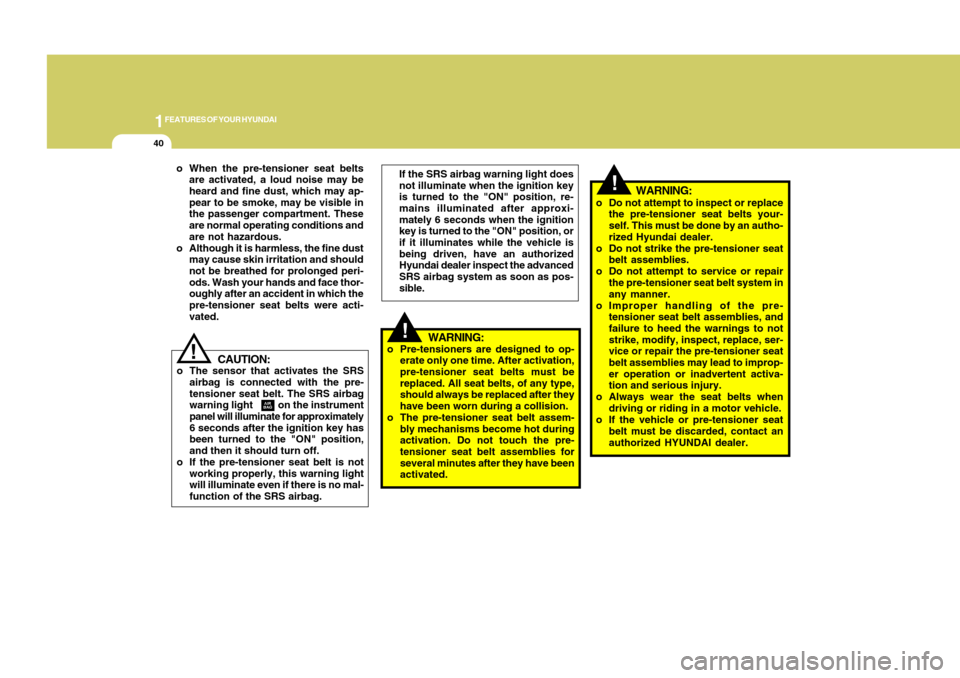
1FEATURES OF YOUR HYUNDAI40
!
!
WARNING:
o Pre-tensioners are designed to op-
erate only one time. After activation,
pre-tensioner seat belts must be
replaced. All seat belts, of any type,
should always be replaced after they
have been worn during a collision.
o The pre-tensioner seat belt assem-
bly mechanisms become hot during
activation. Do not touch the pre-
tensioner seat belt assemblies for
several minutes after they have been
activated.o Do not attempt to inspect or replace
the pre-tensioner seat belts your-
self. This must be done by an autho-
rized Hyundai dealer.
o Do not strike the pre-tensioner seat
belt assemblies.
o Do not attempt to service or repair
the pre-tensioner seat belt system in
any manner.
o Improper handling of the pre-
tensioner seat belt assemblies, and
failure to heed the warnings to not
strike, modify, inspect, replace, ser-
vice or repair the pre-tensioner seat
belt assemblies may lead to improp-
er operation or inadvertent activa-
tion and serious injury.
o Always wear the seat belts when
driving or riding in a motor vehicle.
o If the vehicle or pre-tensioner seat
belt must be discarded, contact an
authorized HYUNDAI dealer.
WARNING:
CAUTION:
o The sensor that activates the SRS
airbag is connected with the pre-
tensioner seat belt. The SRS airbag
warning light on the instrument
panel will illuminate for approximately
6 seconds after the ignition key has
been turned to the "ON" position,
and then it should turn off.
o If the pre-tensioner seat belt is not
working properly, this warning light
will illuminate even if there is no mal-
function of the SRS airbag.
!
o When the pre-tensioner seat belts
are activated, a loud noise may be
heard and fine dust, which may ap-
pear to be smoke, may be visible in
the passenger compartment. These
are normal operating conditions and
are not hazardous.
o Although it is harmless, the fine dust
may cause skin irritation and should
not be breathed for prolonged peri-
ods. Wash your hands and face thor-
oughly after an accident in which the
pre-tensioner seat belts were acti-
vated.If the SRS airbag warning light does
not illuminate when the ignition key
is turned to the "ON" position, re-
mains illuminated after approxi-
mately 6 seconds when the ignition
key is turned to the "ON" position, or
if it illuminates while the vehicle is
being driven, have an authorized
Hyundai dealer inspect the advanced
SRS airbag system as soon as pos-
sible.